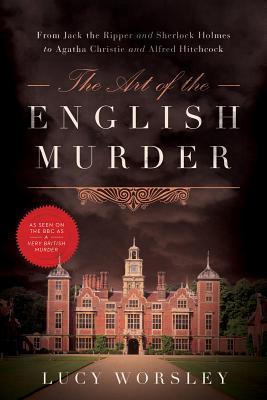 Welcome to British Isles Friday! British Isles Friday is a weekly event for sharing all things British and Irish - reviews, photos, opinions, trip reports, guides, links, resources, personal stories, interviews, and research posts. Join us each Friday to link your British and Irish themed content and to see what others have to share. The link list is at the bottom of this post. Pour a cup of tea or lift a pint and join our link party!
Welcome to British Isles Friday! British Isles Friday is a weekly event for sharing all things British and Irish - reviews, photos, opinions, trip reports, guides, links, resources, personal stories, interviews, and research posts. Join us each Friday to link your British and Irish themed content and to see what others have to share. The link list is at the bottom of this post. Pour a cup of tea or lift a pint and join our link party!
Last week, I watched the Miss Marple series with Joan Hickson. Heather enjoyed a new holiday-themed novel set in a British village, The Village Inn of Secret Dreams. Tina enjoyed several settings in Under the Golden Sun, including Ilfracombe in Devon.
Book: The Art of the English Murder: From Jack the Ripper and Sherlock Holmes to Agatha Christie and Alfred Hitchcock by Lucy Worsley
Genre: nonfiction
Publisher: Pegasus
Publication date: 2014
Pages: 312
Source: electronic audiobook borrowed from the library + print book borrowed from the library
Summary: My fascination with Agatha Christie has grown to a desire to learn more about the art of the English murder. Fortunately, Lucy Worsley, my favorite British historian, wrote a book with that title.
The first murders covered in The Art of The English Murder are the Ratcliffe Highway murders from December 1811. They began a popular pastime around sensationalized murder that involved everything from fake memoirs to wax figures at Madame Tussaud's to songs like the ballad of Maria Marten.
The taste for sensation combined with older literary traditions, like Gothic novels, produced new styles of fiction. I liked this description of the Victorian melodrama since it's not our usual picture of Victorians:
Victoria melodrama was ghoulish in the extreme: acts of violence, drawn out, prolonged and magnified so as completely to avoid any sense of realism or authenticity. Today it seems almost impossible that it would have been taken seriously. And yet, to its audience, it wasn't a joke. (p. 106)
The Victorians gave us Charles Dickens, Wilkie Collins, and other less-remembered names - some of them women. Later in the 19th century the real crimes get very gory (Jack the Ripper) and the fictional detectives get very rational (Sherlock Holmes).
After a fun chapter on female detectives, we reach the Golden Age:
By the 1930s, the murder rate had fallen to the lowest level Britain had ever seen. Those crimes that did take place were usually linked to poverty, alcohol or domestic violence. And yet it seemed that more and more killings, usually in genteel and pleasant surroundings, were taking place in the pages of books.... The decades between the two world wars saw a great explosion of fictional death by the novelists of the so-called 'Golden Age' of detective fiction. There stories were ever more remote from real-life violence and true crime. In them, murders became tidy and domesticated. (p. 223)
 Thoughts: I enjoy the psychology of reading. Years ago, I learned that romance fiction helped those of us who were raised to be like our mothers, but ended up with careers that were more like our fathers. We needed to integrate the male and female parts of our selves into a coherent whole. I felt that in my bones.
Thoughts: I enjoy the psychology of reading. Years ago, I learned that romance fiction helped those of us who were raised to be like our mothers, but ended up with careers that were more like our fathers. We needed to integrate the male and female parts of our selves into a coherent whole. I felt that in my bones.
I loved this analysis of the role of the detective novel in The Art of the English Murder:
Even beyond the annual commemoration of Remembrance Day, the lasting effects of the Great War could not be ignored or avoided. Children were left orphaned, the surviving young men left wounded in ways both seen and unseen, young women left without partners. This is the background that should be born in mind when the Golden Age writers are criticized - as they often are - for being limited or sterile or boring. They were writing not to challenge society or to stir things up. They were using their pens to heal. (p. 228)
These mystery novels presented cerebral puzzles to be solved and provided those solutions in a satisfying and compelling way. The detectives always solved the crime and the criminals met justice, in some form or another.
Appeal: I listened to the audiobook, to start, but requested the print book, too. I wanted to look at the pictures. There were some sprinkled throughout plus a center section, including photos of the many souvenirs that popped up in merchandising around murders in the nineteenth century.
It definitely helps to read this book for a Halloween-themed challenge. I wouldn't always be in the mood for descriptions of murder and its aftermath, no matter how artful. If you're in the mood for murder and mystery, The Art of the English Murder is an excellent history book that covers a broad array of topics like the changing roles of women; the economic ups and downs and the impact on, especially, poor and middle-class people; and the development of a particular aspect of entertainment that continues in the modern age.
Have you read this book? What did you think?
 I engaged with Agatha Christie for my first five R.eader's I.mbibing P.eril posts in 2021.
I engaged with Agatha Christie for my first five R.eader's I.mbibing P.eril posts in 2021.
Next week, look for a ghoulish adventured inspired by The Art of the English Murder.

About Joy Weese Moll
a librarian writing about books
